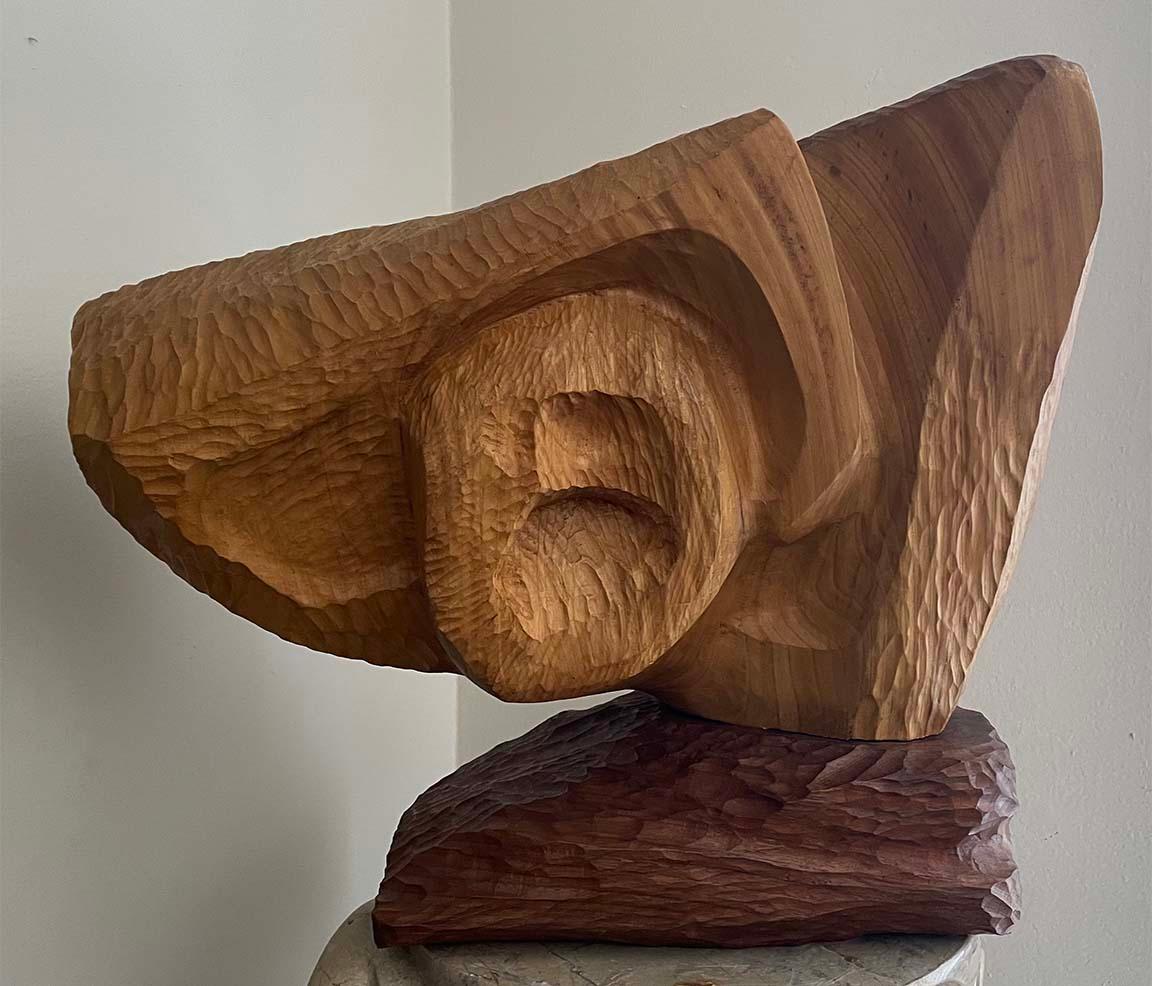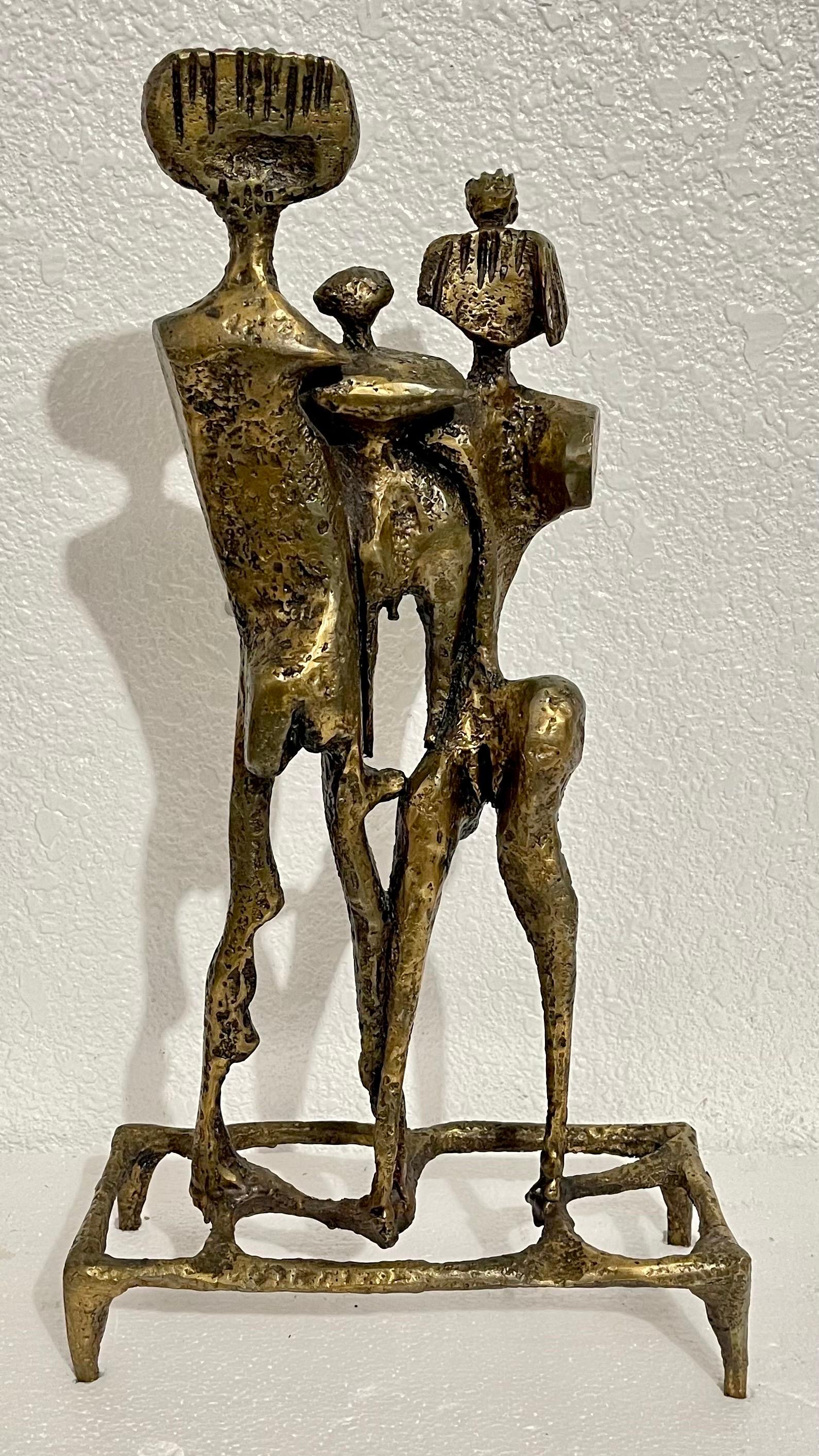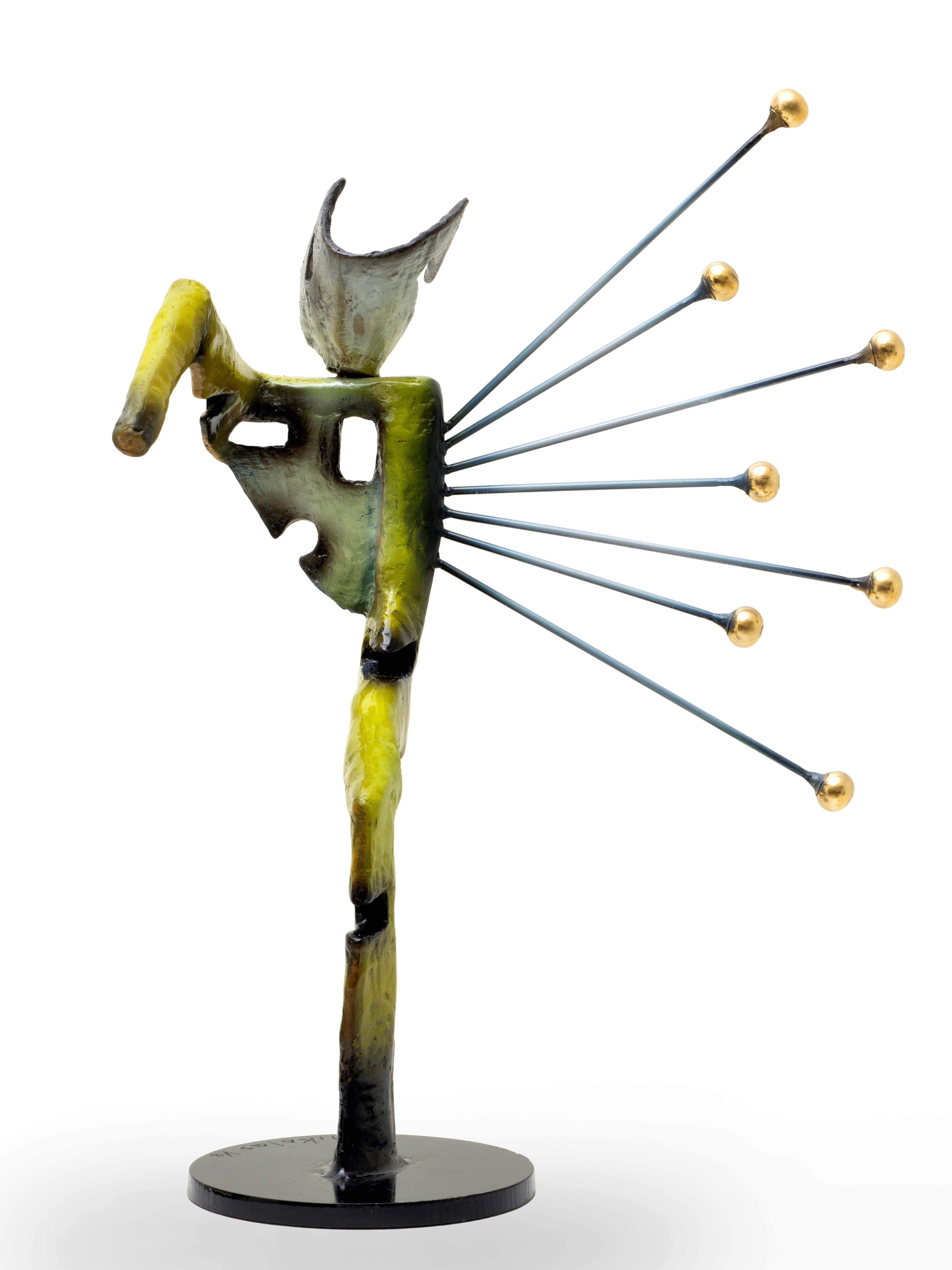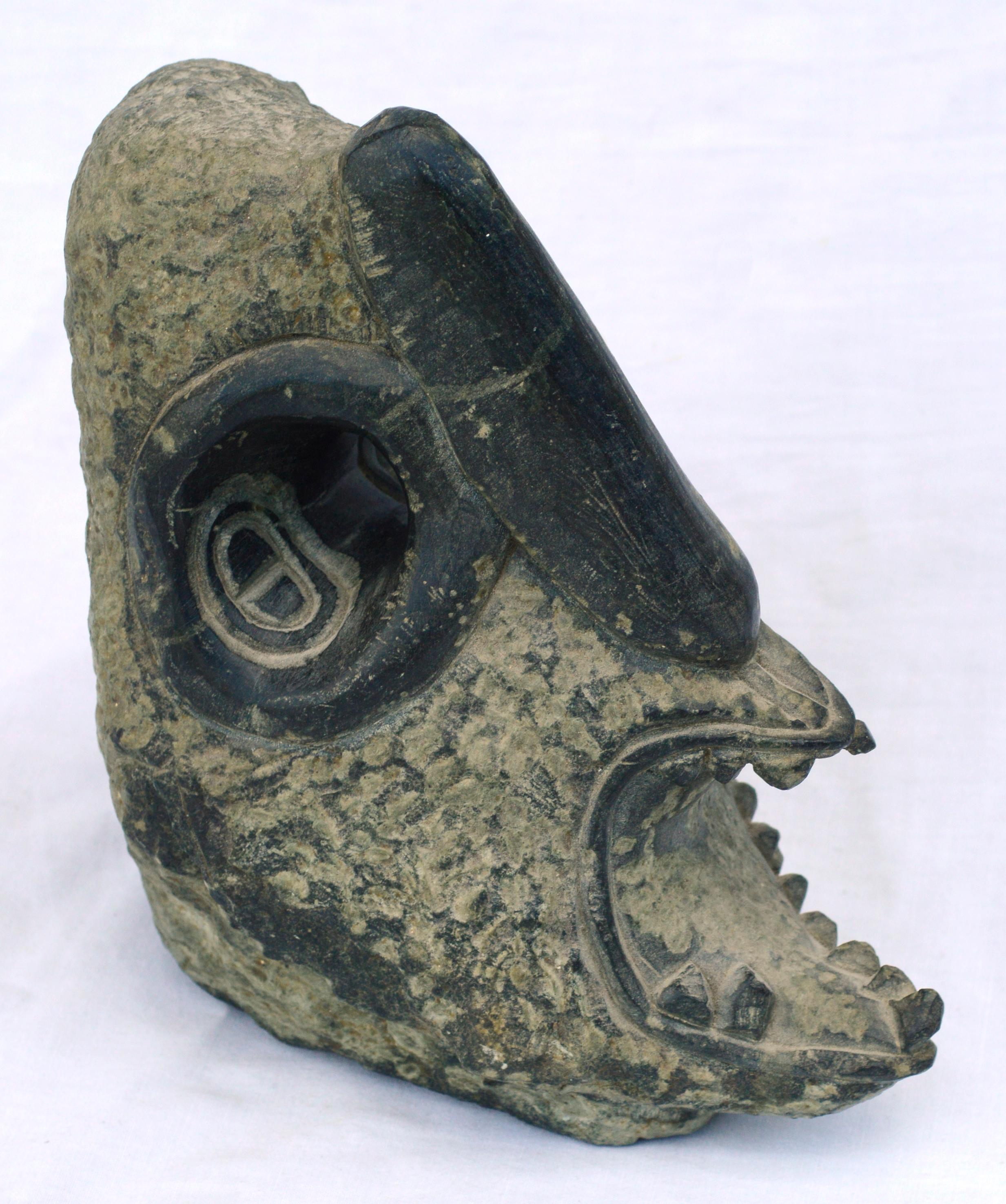Items Similar to Carved Wood German Expressionist Sculpture Jewish Woman Refugee Artist Judaica
Want more images or videos?
Request additional images or videos from the seller
1 of 13
Miriam SommerburgCarved Wood German Expressionist Sculpture Jewish Woman Refugee Artist Judaicac.1950s
c.1950s
About the Item
Miriam Sommerburg (American female artist, born Germany, Hamburg, 1900–1980 New York)
Modernist Wood Carved Sculpture, Carving depicting a family group.
Before being forced to flee Germany during the outbreak of World War II, Miriam Sommerburg had an established career as a prominent and sought-after woodcut artist. There she studied with Richard Luksch (he belonged to the group around Gustav Klimt and left the Wiener Sezession with him in 1905. Created works for the Wiener Werkstatte) and Friederich Alder. Ultimately, she settled in the United States and began to explore a vast range of materials and techniques, including oil painting, watercolor, other methods of printmaking, and wood carving sculpture. At times, she applied her woodblock techniques to these new media—for example, by using incisions to add texture to a painting. Sommerberg was interested in exploring relationships and human emotions, which did not waver through her move. She famously said, “Art doesn’t belong on a pedestal. It belongs to the ordinary people and should be treated honestly.”
Sommerburg would find international renown and go on to have her works displayed at the Boston Art Museum, the 1964 World’s Fair in New York City and the United States Holocaust Memorial Museum. and the Ghetto Fighters House Archives at Kibbutz Lohamei Hagetaot, a community of Holocaust refugees and survivors, among them fighters of the ghetto undergrounds and partisan units in Israel.
In 1944, as the Allies continued to gain ground in Europe and the Nazi atrocities came to light, President Franklin D. Roosevelt allowed 1000 refugees into the country as personal guests. These guests would be staying at Fort Ontario in the city of Oswego, New York. Refugees came from Italy, Germany, and many other countries throughout Europe. Miriam was one of those refugees who stayed at the fort in the 1940s. Miriam Sommerburg went to Greenwich Village New York after the Shelter closed in 1946 and produced an impressive body of work. She held nine one woman shows, won numerous prizes and watched her work being added to the permanent collections of several museums, including the New York Metropolitan Museum of Art.
She studied with Richard Luksich and Friedrich Adler. She exhibited at Syracuse Museum, California Society of Etchers, Society of American Graphic Art, Allied Art of America, Audubon Artists, National Association of Women Artists, Boston Art Museum and was invited to participate in the Ford Foundation Grants and the Academy of Arts & Letters.
- Creator:Miriam Sommerburg (1908 - 1980, German)
- Creation Year:c.1950s
- Dimensions:Height: 13 in (33.02 cm)Width: 12 in (30.48 cm)
- Medium:
- Movement & Style:
- Period:
- Condition:good. minor wear commensurate with age.
- Gallery Location:Surfside, FL
- Reference Number:1stDibs: LU3826376382
About the Seller
4.9
Platinum Seller
These expertly vetted sellers are 1stDibs' most experienced sellers and are rated highest by our customers.
Established in 1995
1stDibs seller since 2014
1,560 sales on 1stDibs
Typical response time: 1 hour
- ShippingRetrieving quote...Ships From: Surfside, FL
- Return PolicyA return for this item may be initiated within 3 days of delivery.
More From This SellerView All
- Large Aharon Bezalel Israeli Modernist Bronze Brutalist Puzzle Sculpture FiguresBy Aharon BezalelLocated in Surfside, FLAharon Bezalel (Afghani-Israeli, 1925-2012) Family Grouping Hand signed in with initials in English Figures fit together like puzzle pieces in solid cast bronze with original patina. Aharon Bezalel (born Afghanistan 1926) Born in Herat, Afghanistan in 1926 and immigrated to Israel at an early age. His father, Reuven Bezalel, was a rabbi and kabbalist. As a youth Aharon studied gold and silver casting as well as applied arts and worked in these fields as a silversmith and judaica craftsman, and was a student of the sculptor Zev Ben-Zvi at the Bezalel Academy for Art & Design where he also studied with Isidor Ascheim and Mordecai Ardon. There he absorbed the basic concepts of classic and modernist art and interpreted, according to them, ideas based on ancient Hebrew sources. He also studied miniature carving with the artists Martin and Helga Rost applying himself at their workshop. Aharon Bezalel worked and resided in Jerusalem, he taught art for many years. His sculptures - works of wood, bronze, aluminum, Plexiglas - were shown at his studio in Ein Kerem. “I saw myself as part of this region. I wanted to find the contact between my art and my surroundings. Those were the first years of Jean Piro’s excavations at the Beer-Sheba mound. They found there, for example, the Canaanite figurines that I especially liked and that were an element that connected me with the past and with this place.” “…a seed and sperm or male and female. These continue life. The singular, the individual alone, cannot exist; I learned this from my father who dabbled with the Kabbalah.” (Aharon Bezalel, excerpt from an interview with David Gerstein) “The singular in Aharon Bezalel’s work is always potentially a couple if not a threesome, the one is also the many: when the individual is revealed within the group he will always seek a huddling, a clinging together. The principle of modular construction is required by this perception of unity and multiplicity, as modular construction in his work is an act of conception or defense. His work bears a similarity to Berrocal as well as affinities to Henry Moore, Lynne Chadwick and Kenneth Armitage. Two poles of unity, potentially alone, exist in A. Bezalel’s world: From a formal, sculptural sense these are the sphere and pillar, metaphorically these are the female in the final stages of pregnancy and the solitary male individual. Sphere-seed-woman; Pillar-strand-man. The disproportional, small heads in A. Bezalel figures leave humankind in it’s primal physical capacity. The woman as a pregnancy or hips, the man as an aggressive or defensive force, the elongated chest serves as a phallus and weapon simultaneously. (Gideon Ofrat) EIN HAROD About the Museum's Holdings: Israeli art is represented by the works of Reuven Rubin, Zaritzky, Nahum Gutman...Category
Mid-20th Century Expressionist Abstract Sculptures
MaterialsBronze
- Large Aharon Bezalel Israeli Modernist Bronze Brutalist Puzzle Sculpture FiguresBy Aharon BezalelLocated in Surfside, FLAharon Bezalel (Afghani-Israeli, 1925-2012) 1984 Edition 4/9 Family Grouping Hand signed in Hebrew with initials and in English Movable figures that fit together like puzzle pieces in solid cast bronze with original patina on a lucite bench base. 23 X 19 X 6 base is 24 X 6 X 6 Aharon Bezalel (born Afghanistan 1926) Born in Herat, Afghanistan in 1926 and immigrated to Israel at an early age. His father, Reuven Bezalel, was a rabbi and kabbalist. As a youth Aharon studied gold and silver casting as well as applied arts and worked in these fields as a silversmith and judaica craftsman, and was a student of the sculptor Zev Ben-Zvi at the Bezalel Academy for Art & Design where he also studied with Isidor Ascheim and Mordecai Ardon. There he absorbed the basic concepts of classic and modernist art and interpreted, according to them, ideas based on ancient Hebrew sources. He also studied miniature carving with the artists Martin and Helga Rost applying himself at their workshop. Aharon Bezalel worked and resided in Jerusalem, he taught art for many years. His sculptures - works of wood, bronze, aluminum, Plexiglas - were shown at his studio in Ein Kerem. “I saw myself as part of this region. I wanted to find the contact between my art and my surroundings. Those were the first years of Jean Piro’s excavations at the Beer-Sheba mound. They found there, for example, the Canaanite figurines that I especially liked and that were an element that connected me with the past and with this place.” “…a seed and sperm or male and female. These continue life. The singular, the individual alone, cannot exist; I learned this from my father who dabbled with the Kabbalah.” (Aharon Bezalel, excerpt from an interview with David Gerstein) “The singular in Aharon Bezalel’s work is always potentially a couple if not a threesome, the one is also the many: when the individual is revealed within the group he will always seek a huddling, a clinging together. The principle of modular construction is required by this perception of unity and multiplicity, as modular construction in his work is an act of conception or defense. His work bears a similarity to Berrocal as well as affinities to Henry Moore, Lynne Chadwick and Kenneth Armitage. Two poles of unity, potentially alone, exist in A. Bezalel’s world: From a formal, sculptural sense these are the sphere and pillar, metaphorically these are the female in the final stages of pregnancy and the solitary male individual. Sphere-seed-woman; Pillar-strand-man. The disproportional, small heads in A. Bezalel figures leave humankind in it’s primal physical capacity. The woman as a pregnancy or hips, the man as an aggressive or defensive force, the elongated chest serves as a phallus and weapon simultaneously. (Gideon Ofrat) EIN HAROD About the Museum's Holdings: Israeli art is represented by the works of Reuven Rubin, Zaritzky, Nahum Gutman...Category
Mid-20th Century Expressionist Abstract Sculptures
MaterialsBronze
- Liberty vs Slavery Van Loen Bronze Abstract Chess Set Modernist Museum SculptureBy Alfred Van LoenLocated in Surfside, FLAlfred Van Loen signed 32 piece chess set. In heavy solid bronze. Rare Chess Game: Liberty versus Slavery Dimensions: a) Joy-Tenderness H. 6 3/16 in. a...Category
1960s Expressionist Abstract Sculptures
MaterialsBronze
- Rachid Khimoune French Algerian Arab Art Brut Bronze Sculpture Abstract FigureLocated in Surfside, FLRachid Khimoune (Algerian, b. 1953) Les enfants du monde bronze. signed and numbered artist's edition of 4 foundry mark - L. Cappe 7.5 x 4.63 x 2.38 Overall: 8.25 x 4.63 x 2.38 RACHID KHIMOUNE, Algerian-French artist and sculptor. Born in 1953 in Decazeville, France. Lives and works in Paris, France. Rachid Khimoune graduated from the School of Art of Paris in 1974; he initially started to work with painting before choosing sculpture. In 1980 he won the first prize of the Foundation of France. He works in an Art Brut, Naif art style similar to Jean Dubuffet and Enrico Baj. Being the recipient of numerous prestigious awards and an extensive oeuvre, Rachid Khimoune has been exhibiting since 1975 and his work can be found in several museums, and public and private collections. The artist behind the project Rachid Khimoune, has been responsible for a number of major, successful public art installations in France. Most famously, the installation close to the Bibliothèque Nationale (National Library) ‘Les Enfants du Monde’ (The Children of the World). Rachid’s newer works are masks and totems cast in bronze: poetic images forged in a furnace. Rachid uses discarded objects and disused parts of machines, to create new human and animal forms. Here his interest in metal-working and Arab art-African art coincides with the assemblage of found objects; one mask is a collage constituted by a large model of the Eiffel Tower stuck into the end of a trumpet. Another has a jerry-can for a face, and the golden patina and surface-working of the bronze does not dispel the idea which this image creates: of a human mouth drinking oil. Born in France to parents from Algeria, Khimoune embraces the role of the artist as a global citizen, using art as a universal language. Select Awards Lauréat du Prix de la Fondation de France (1980) Chevalier des Arts et Lettres (2002) Grande Médaille de la Ville de Paris (2004) Chevalier de la Légion d’Honneur (2007) EXHIBITIONS SOLO EXHIBITIONS 2017 Ar[T]senal, Dreux, France 2016 Musée Tavet Delacour, Pontoise, France 2015 Parvis de l’Hotel de ville, Paris 2015 Beirut Art Fair, Beyrouth, Liban 2015 Galerie Francoise Souchaud, Lyon 2014 Musée Rabelais, Seuilly, France 2013 Galerie Vallois...Category
20th Century Expressionist Abstract Sculptures
MaterialsBronze
- Blas Castagna Hand Painted Wooden Constructivist Sculpture Toy Horse Carved WoodLocated in Surfside, FLBlas Alfredo Castagna was born in Buenos Aires, Argentina in 1935. He studied at the Manuel Belgrano National School of Fine Arts and at the Prilidiano Pueyrredón School, where he obtained the title of National Professor of Drawing and Decorator Painter. In 1959 he traveled to Italy and in Sicily he attended the metal-beating workshop at the Scuola d´Arte di Comiso. A year later, he had a solo show of oil painting and gouaches at the “Alcora” Gallery in Buenos Aires, also presenting it in the province of San Juan. In addition to his artistic activity, he worked between 1974 and 1976 as a teacher in the Department of Plastic Arts, Faculty of Humanities, of the National University of San Juan. In 1982 he was invited to exhibit plates and monotypes at the Galerie de L´Université - Tour Mauran in Toulouse, France. A year later he exhibited in our country at the Van Riel Gallery, where a long connection with this room begins. In 1998 he exhibited again in Toulouse, at the Espace Croix Baragnon, an exhibition entitled "Origins, Mémoide", also presenting that year, at the Enrique Larreta Museum of Spanish Art in Buenos Aires, his "Obra Figurativa 1973-1993". Collectively, he presents his works in Uruguay, Cuba, Spain, at the Museum of Modern Art in Buenos Aires and at the National Museum of Fine Arts, at the Borges Cultural Center (2007 and 2008), at the Museum of Modern Art in Bahia ( Brazil, 2005), at the Sainsbury Center Norwich (United Kingdom, 2004), Centro Cultural Recoleta (1999), at the Fortabat Foundation (1985), at the II Biennial of Havana (1986) and at the ARCO fair in Madrid ( 1987). In 1990 he was awarded the Spirit of Greece Award for engraving, and in 1992 the “Konex Platinum Award. His work is influenced by the Latin American geometric constructivism present in Argentina and Uruguay as well as the European influences of Surrealism and Dada Art. He showed at the prestigious van Riel Gallery. For over 80 years the Frans van Riel Gallery has exhibited at the forefront of Argentinean art. Beginning with Alfredo Hlito “Grupo de Artistas Modernos de la Argentina” (Argentinian Modern Artists). The avant-garde of the 1950s and the work of Kenneth Kemble, Leónidas Gambartes and the Grupo Litoral, Juan Del Prete, Aldo Paparella sculpture, Julio Llinás, Aldo Pellegrini, Juan Batlle Planas, Libero Badii, Malena Babino, Horacio Butler, Alejandro Corujeira, Juan Del Prete, Kirin, Luis Felipe Noé...Category
20th Century Neo-Constructivist Figurative Sculptures
MaterialsFabric, Wood, Paint
- Abstract Geometric Cubist Painted Wood Sculpture Head Italian Neo Figurative ArtBy Italo ScangaLocated in Surfside, FLThis painted wood assemblage sculpture by Italo Scanga, epitomizes the characteristics of his oeuvre. Polychrome head portrait bust. This was signed on a brass or bronze plaque but that has gone missing. It is unsigned. I believe there might be a studio stamp on the bottom. Italo Scanga (June 6, 1932 - July 7, 2001), an Italian-born American artist, was known for his sculptures, prints and, paintings, mostly created from found objects. In his youth in Calabria, Italy he worked as a cabinetmaker's apprentice and studies sculpture with a man who carved statues of saints. Italo Scanga was an innovative neo Dada, neo-Expressionist, and neo-Cubist multimedia artist who made assemblage, collage, sculptures of ordinary objects and created prints, glass, and ceramic works. Modern Italian abstract geometric folk art. Scanga's materials included natural objects like branches and seashells, as well as kitsch figurines, castoff musical instruments and decorative trinkets salvaged from flea markets and thrift shops. He combined these ingredients into free-standing assemblages, which he then painted. Although visually ebullient, the results sometimes referred to gruesome episodes from Greek mythology or the lives and deaths of martyred saints. He considered his artistic influences to be sweepingly pan-cultural, from African sculpture to Giorgio de Chirico. He often collaborated with the sculptor Dale Chihuly, who was a close friend. Constructed of wood and glass, found objects or fabric, his ensembles reflect a trio of activities—working, eating, and praying. These activities dominate the lives of those who live close to the land, but they are also activities that are idealized by many who contemplate, romantically, a simpler, bucolic life. Italo graduated from Michigan State University where he befriended fellow artists Richard Merkin and David Pease. He studied under Lindsey Decker who introduces him to welding and sculpture after his initial interest in photography. Also studies with Charles Pollock, the brother of Abstract Expressionist Jackson Pollock. His first teaching job was at University of Wisconsin (through 1964). where he met Harvey Littleton, a fellow instructor. He later moves to Providence, Rhode Island,I to teach at Rhode Island School of Design (RISD). Is colleagues with artists Richard Merkin and Hardu Keck. Starts a correspondence with HC Westermann. Spends summers teaching at Brown University; colleague of Hugh Townley. Moves to State College, PA, and teaches at Pennsylvania State University for one year. Meets artists Juris Ubans, Harry Anderson, Richard Frankel, and Richard Calabro, who remain friends throughout his career. 1967: David Pease helps him get a tenure track position at Tyler School of Art in Philadelphia, PA, . Artists he works closely with include Ernest Silva, Lee Jaffe, Donald Gill, and William Schwedler. Meets graduate student Dale Chihuly while lecturing at RISD and develops a lifelong friendship. 1969: One person exhibition, Baylor Art Gallery, Baylor University, Waco, TX. Works very closely with students Larry Becker and Heidi Nivling (who later run a gallery in Philadelphia, PA), and Harry Anderson. Welcomes many artists into his home including Donald Judd, Dan Flavin, Bruce Nauman (a former student), Vito Acconci, Ree Morton and Rafael Ferrer. 1973: "Saints Glass" at 112 Greene Street Gallery, NYC. Installation at the Institute of Contemporary Art at University of Pennsylvania, Philadelphia, PA. Meets Gordon Matta Clark and contributes to an artist cookbook. Goes to Pilchuck Glass School, Stanwood, WA, founded by Dale Chihuly, as a visiting artist. He continues to work there annually through 2001. Works over the years with Pilchuck artists Richard Royal, Seaver Leslie, Jamie Carpenter, Joey Kirkpatrick, Flora Mace, Robbie Miller, Billy Morris, Buster Simpson, Toots Zynsky, Howard Ben Tre...Category
1980s Cubist Abstract Sculptures
MaterialsWood, Oil
You May Also Like
- The ScreamLocated in Los Angeles, CAJOAN STRAUSS CAROL "THE SCREAM" WOOD, SIGNED, TITLED CALIFORNIA, DATED 1984 1575 X 19 INCHES Joan Strauss Carl 1926-2021 Joan Strauss Carl was...Category
1980s Expressionist Figurative Sculptures
MaterialsWood
- Martenita Tribute to Picasso Murano Glass SculptureBy Walter FurlanLocated in Lake Worth Beach, FLMartenita Omaggio To Picasso, Signed, artist logo stamp, and title. Walter Furlan was born (1931-2018) in Chioggia, a small town near Venice. He started to work in a furnace calle...Category
Early 2000s Expressionist Figurative Sculptures
MaterialsGlass, Blown Glass
- HomodeusLocated in Spetses, GRInspired by the writings of historian Yuval Noah Harari, Homo Deus creates a vision of the future: of Man physically transformed by new technologies to the point of attaining a statu...Category
21st Century and Contemporary Expressionist Abstract Sculptures
MaterialsBronze
- Vintage Figurative Abstract Tribal Creature Head SculptureBy Nathaniel SirlesLocated in Soquel, CAEvocative figurative abstract sculpture of the head of a tribal creature by Nathaniel Sirles (American, b. 1954). Signed and dated "N. Sirles 1970" on the bottom. Sirles completed th...Category
1970s Expressionist Figurative Sculptures
MaterialsStone
- Maasai Warrior - African Sculpture in Bronze Verdigris - Limited EditionLocated in Pretoria, ZAMaasai Warrior in Bronze Verdigris on Sandstone base, limited edition of 24 (signed and numbered); H 76 cm including base. Having been a professional safari guide, my art is influenc...Category
2010s Expressionist Figurative Sculptures
MaterialsSandstone, Bronze
- Zulu Warrior - African Bronze Sculpture - Limited EditionLocated in Pretoria, ZAZulu Warrior in Bronze with traditional patina. Limited edition of 24 (signed & numbered), Sculpture in Bronze Verdigris on Sandstone base. Height 70 cm including base. My art is ins...Category
2010s Expressionist Figurative Sculptures
MaterialsSandstone, Bronze
Recently Viewed
View AllMore Ways To Browse
European Wood Sculpture
German Wood Sculpture
Carved Italian Wood Sculptures
Female Wood Sculpture
Carved Sculpture Woman
Wood Woman Carved
Wood Pedestal For Sculpture
Watch For A Woman
1950s German Modernist
Carved Wood Female Sculpture
Midcentury Wood Modernist Sculpture
Wood Female Carving
Vintage German Watches
German Vintage Watch
Vintage Wood Letters
Carved Woman Sculpture Wood
Wood Carved Sculpture Of Woman
German Carving Sculpture Wood





